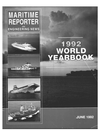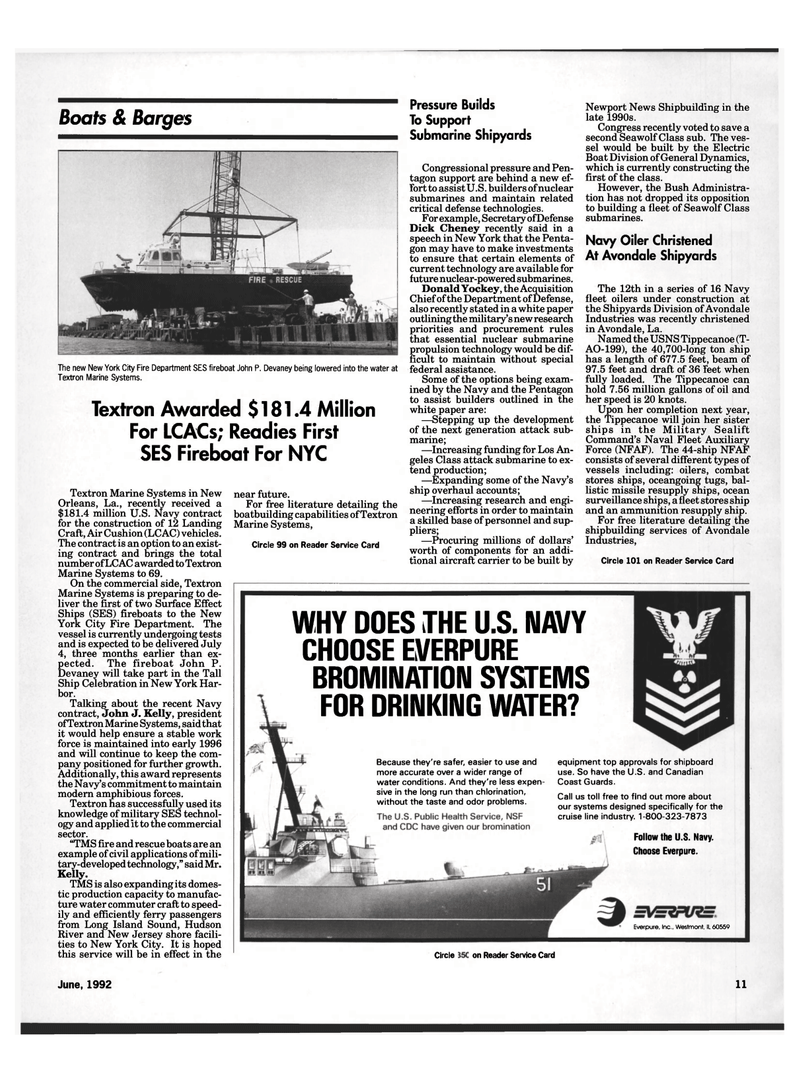
Page 9: of Maritime Reporter Magazine (June 1992)
Read this page in Pdf, Flash or Html5 edition of June 1992 Maritime Reporter Magazine
Boats & Barges
The new New York City Fire Department SES fireboat John P. Devaney being lowered into the water at
Textron Marine Systems.
Textron Awarded $181.4 Million
For LCACs; Readies First
SES Fireboat For NYC
Textron Marine Systems in New
Orleans, La., recently received a $181.4 million U.S. Navy contract for the construction of 12 Landing
Craft, Air Cushion (LCAC) vehicles.
The contract is an option to an exist- ing contract and brings the total number of LCAC awarded to Textron
Marine Systems to 69.
On the commercial side, Textron
Marine Systems is preparing to de- liver the first of two Surface Effect
Ships (SES) fireboats to the New
York City Fire Department. The vessel is currently undergoing tests and is expected to be delivered July 4, three months earlier than ex- pected. The fireboat John P.
Devaney will take part in the Tall
Ship Celebration in New York Har- bor.
Talking about the recent Navy contract, John J. Kelly, president ofTextron Marine Systems, said that it would help ensure a stable work force is maintained into early 1996 and will continue to keep the com- pany positioned for further growth.
Additionally, this award represents the Navy's commitment to maintain modern amphibious forces.
Textron has successfully used its knowledge of military SES technol- ogy and applied it to the commercial sector. "TMS fire and rescue boats are an example of civil applications of mili- tary-developed technology," said Mr.
Kelly.
TMS is also expanding its domes- tic production capacity to manufac- ture water commuter craft to speed- ily and efficiently ferry passengers from Long Island Sound, Hudson
River and New Jersey shore facili- ties to New York City. It is hoped this service will be in effect in the near future.
For free literature detailing the boatbuilding capabilities ofTextron
Marine Systems,
Circle 99 on Reader Service Card
Pressure Builds
To Support
Submarine Shipyards
Congressional pressure and Pen- tagon support are behind a new ef- fort to assist U.S. builders of nuclear submarines and maintain related critical defense technologies.
For example, Secretary of Defense
Dick Cheney recently said in a speech in New York that the Penta- gon may have to make investments to ensure that certain elements of current technology are available for future nuclear-powered submarines.
Donald Yockey, the Acquisition
Chief of the Department of Defense, also recently stated in a white paper outlining the military's new research priorities and procurement rules that essential nuclear submarine propulsion technology would be dif- ficult to maintain without special federal assistance.
Some of the options being exam- ined by the Navy and the Pentagon to assist builders outlined in the white paper are: —Stepping up the development of the next generation attack sub- marine; —Increasing funding for Los An- geles Class attack submarine to ex- tend production; —Expanding some of the Navy's ship overhaul accounts; —Increasing research and engi- neering efforts in order to maintain a skilled base of personnel and sup- pliers; —Procuring millions of dollars' worth of components for an addi- tional aircraft carrier to be built by
Newport News Shipbuilding in the late 1990s.
Congress recently voted to save a second Seawolf Class sub. The ves- sel would be built by the Electric
Boat Division of General Dynamics, which is currently constructing the first of the class.
However, the Bush Administra- tion has not dropped its opposition to building a fleet of Seawolf Class submarines.
Navy Oiler Christened
At Avondale Shipyards
The 12th in a series of 16 Navy fleet oilers under construction at the Shipyards Division of Avondale
Industries was recently christened in Avondale, La.
Named the USNS Tippecanoe (T-
AO-199), the 40,700-long ton ship has a length of 677.5 feet, beam of 97.5 feet and draft of 36 feet when fully loaded. The Tippecanoe can hold 7.56 million gallons of oil and her speed is 20 knots.
Upon her completion next year, the Tippecanoe will join her sister ships in the Military Sealift
Command's Naval Fleet Auxiliary
Force (NFAF). The 44-ship NFAF consists of several different types of vessels including: oilers, combat stores ships, oceangoing tugs, bal- listic missile resupply ships, ocean surveillance ships, a fleet stores ship and an ammunition resupply ship.
For free literature detailing the shipbuilding services of Avondale
Industries,
Circle 101 on Reader Service Card
WHY DOES THE U.S. NAVY
CHOOSE EVERPURE
BROMINATION SYSTEMS
FOR DRINKING WATER?
Because they're safer, easier to use and more accurate over a wider range of water conditions. And they're less expen- sive in the long run than chlorination, without the taste and odor problems. equipment top approvals for shipboard use. So have the U.S. and Canadian
Coast Guards.
Call us toll free to find out more about our systems designed specifically for the cruise line industry. 1-800-323-7873
Follow the U.S. Navy.
Choose Everpure.
Everpure, Inc., Westmont, IL 60559
Circle 268 on Reader Service Card
June, 1992 11

 8
8

 10
10
